In short from a Holiday Travel point of view.It tells a story of culture and violence over more than thousand five hundred years. Around two thousand religious edifices and ruins still stand from that time in the dusty plains of central Myanmar just beside the Irrawaddy or Ayeyarwady river. Long time ago there were over 4000 of them but, decay, flooding and several earthquakes made them crumble and been washed away. Wars and in fights within the dynasties and families took its toll. But it still shows a great culture who was able to continue over such a long period of time. The actual end to Myanmar Kings and dynasties came when the British conquered the country.
|
 |
| Myanmar attack at Thailand |
Several wars between the two countries went on between the 16th and 19th century, the last ended with the destruction of the then capital Ayutthaya in 1766. After this the city was moved further south and Bangkok was created, as a matter of fact the Burmese were the aggressors almost every time. It seems to be a similar relationship as with the German and the French. The picture below were made in the Bangkok National Museum and the one above in a Ayutthaya Wat.
 |
| The Burmese &Thai War at Ayutthaya |
5th Century to 830: The Pyu kingdom of Thayekhetaya was founded and temples and pagodas were built plus some Buddhist art in form of sculptures and reliefs in terracotta and stone technique.
849 to 1044: Founding of Bagan in 849 and the attempt to create the first bigger state with the city as center was started, first monument construction started.
1044 to 1077: The ruling dynasty was formed by King Anuruddha. The kingdom was expanded and subjugation of the Mons empire. The ruler brought
Buddhist scriptures or Tripitaka and relics back from Thaton after some battle with the Mon. Theravada Buddhism became the official religion and the traditional Nat cult was integrated into the local Buddhism.
1082 to 1112: Assassination of King Sawla a son of Anuruddha, after his younger son Kyanzittha became the boss. To improve Buddhism Kyanzittha made some cooperation with the Sinhalese.
Mandalay became the capital and
the British came, took over the country and exiled the King and Queen to India, at that time the country was on a level with the Meiji Dynasty in Japan at Mandalay they even had the first Streetcar in Asia.
 |
| British Army kill local people |
The British colonialists destroyed a lot, stole plenty and looted the country since they wanted to keep it as a a place to deliver raw material only, such as wood, simple textiles and other. At that time old Bagan was already of no importance. Only by the mid of the last century the area got a "weak up call" when the first tourist came in on a culture trip. Some of the first were historians from Russia, before USSR and East Germany.
With two thousand pagodas & temples on the Irrawaddy River east side, this old city is a historic treasure. Many years of waste and decay have gone by, still unforgettable views are here. The monuments are spread over around forty square miles on the eastern bank of the Ayeyarwady - river eastwards.
This city was the capital from 1044-1286 A.D. when the empire, so to speak, reached the zenith of its power for the first time. Actually the founding of the city (a group of 19 villages) took place quite early in the dim past (about 107 A.D.), but the illustrious dynasty of temple builders, which made the city strong and famous, started only in 1044 A.D. (i.e. 22 years before the Battle of Hastings in Britain). The story of the city may be told in two parts, before King Anawrahta and after.
Rome, or any other city, wasn’t built in a day and for this city to come into being, it had taken a long time to receive the tradition and influence of three former dynasties, Tagaung, Thaton and Tharekhittaya. At the start (107 A.D.) at Yone-hut kyun it might just have been a fortress or garrison town.
The founder King Thamodarit, paid tribute to his Pyu descent by giving his fortress city the name Paukkan or Pyu Gama (which simply means a Pyu Village.) In everyday usage, the name changed to Bagan.
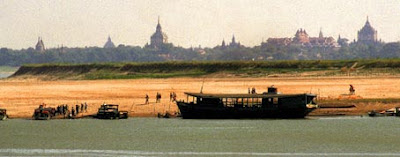 |
| Two thousand pagodas & temples beside the Irrawaddy River |
History is closely connected with King Anawrahta who made Kyaukse the granary of northern Myanmar. He made administrative reforms, dividing the kingdom into districts and appointing officers to look after all affairs and to collect fair revenue. For security, he established 45 out-posts along the border of his kingdom.
In religion and culture, Anawrahta did not encourage the shabby customs of Aris, nor the popular celebrations of nat-pwe's. He looked for a true faith and, in 1056 A.D.
Anawrahta's Kingdom of Bagan.
During Anawrahta’s reign and after, people became so well-versed in the scriptures that, it is said, even village girls could discuss metaphysics with the learned monks from a
Bagan monastery. Then there appeared exceptionally learned persons among the leisurely royal class King Kyaswa, Princess Thanbyin, etc. who held regular classes teaching monks in Pali and Sanskrit texts !
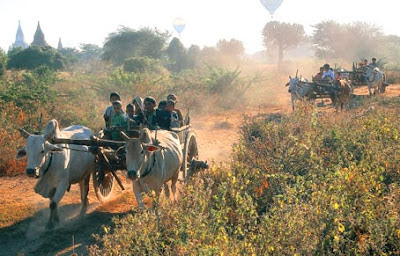 |
| Bagan Myanmar Today, it's dusty and poor |
Thus the place of today, with the remaining two thousand monuments, though grand and splendid in old age, is just a skeleton of the great glorious past.
On certain places it might be useful to hire a local photographer to assist you in finding the right places for pictures taking at the right time.
Myanmar cities used to have at least two names, formal and informal. (Shwebo of the last Konbaung Period had five names.) So, in formal declarations, it was described gradual as Arimaddana Pura, meaning the “City of Conquerors”, and as the name suggested, the first group of kings had quite a hard time just taming and conquering the wild environment.
It is said that from the dense forests around the Irrawaddy River, wild beasts and fabulous birds like rocs harassed the people.
Even wild vegetation of ground bushes overran the paddy fields in the countryside. Brave knights like Pyu Saw Hti (the 3rd, king) appeared to do away with the wild ones. Thus, Hnget-pyit-taung pagoda (where the great roc was shot) and Bit Phaya (where the wild gourd was cleared away) stand Anawrahta’s Kingdom (1044-1298 A.D.)
He was the 42nd. king of the dynasty and he came to the throne in 1044 A.D. He opened the stage of his regency dramatically by fighting and killing his half-brother King Sokkate in single combat.
He was hot-tempered and did many wrongs as a young king. But at heart, he was just and straight-forward, and he tried to repair his wrongs. Anawrahta did many works of public utility, such as repairing Meiktila lake and constructing irrigations and the also the temple building started.
Shin Arahan, known to be a dedicated missionary, came from Thaton. The dedicated monk and the dynamic king met to make the historic changes. Anawrahta became a pure Theravada follower with great zeal. First of all he abolished the Ari gangs, driving some away and forcing most of them to work as lay men.
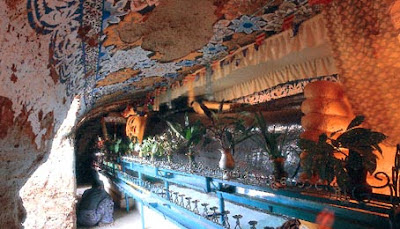 |
| Manuha Temple & Reclining Buddha |
Then to foster the true religion, he needed Buddhist scriptures. Because King Manuha of Thaton bluntly refused his decent request, Anawrahta made war on Thaton (1057 A.D.) and thus destroyed the Mon dynasty.
Thirty-one elephant loads of the scriptures were carried away. Manuha and family were taken prisoners, after he built the Manuha temple. Even the palace sites of the kings had to change four times, though all were in the same vicinity but all possibly would have never existed without the mighty Irrawaddy River.
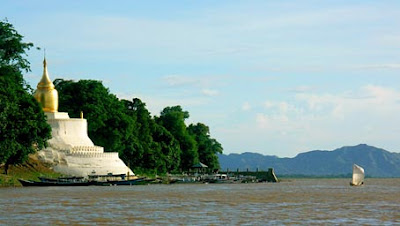 |
| Irrawaddy River Bagan & Pagoda plus small sailing ship |
The present site at the Irrawaddy,
 |
| Tharabar Gate |
With walls and Tharabar Gate as seen today was one of the cities built during the reign of King Pyinbyu in 849 A.D. He was the 34th. king of the Bagan dynasty and started to prosper with commercial relations with Shans, Indian and Chinese in the east, Assam and Manipur in the west and the land of Pyus and Mons in the south.
As regards religion, people of early times, with some Pyus and other natives of the north mixed up, had diverse interests. Horse-riding Aris (monks) with pugilistic habits and other malpractices had migrated from N.W. India and they gained considerable sway over common people.
Then during the reign of Thin-ie-kyaung (344-384 A.D.), the 7th. king of the dynasty, Mahagiri Nats came to Mount Popa and nat-worshipping was popular among all classes. Mount Popa is the abode of the Nats a interesting day trip destination
The city started to decline before the Mongols came in 1287 because all daily life was dedicated to pagoda building. Since that areas were exempted from taxes income and revenues went down dwindled and weakening the state because not much money left for public service.
This was only in economic terms, monument building still went on as ever and also in the same quality, the same aesthetic and quality of craftsmanship, this went on into the mid of the next century. The arrival of the Mongols had no much effect in the lives of locals, the place remained the cultural center for several more hundreds of years until the power shifted north to Ava and Mandalay.
The Mongols.
They where just ignored and embraced, the exotic Mongol warriors were rather a matter of curiosity but not fiends. When the Mongols came in 1287 the city didn't really “fall” to them, naturally the local regime was politically and economically destabilized, tribute and booty must have been paid but nothing really changed well into the 14th century.
Monastic land ownership still increased and temple and pagoda complexes continued to be built and lavishly decorated. Much has changed until now with this high level of devastation over time and treasure hunting hordes. Monasteries kept historical data in scripture chests, among other.


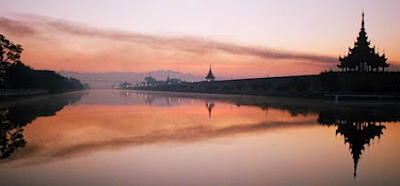


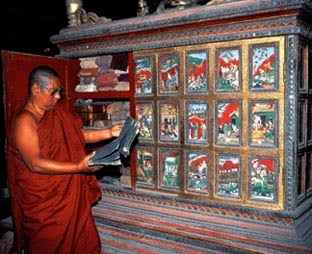
No comments:
Post a Comment